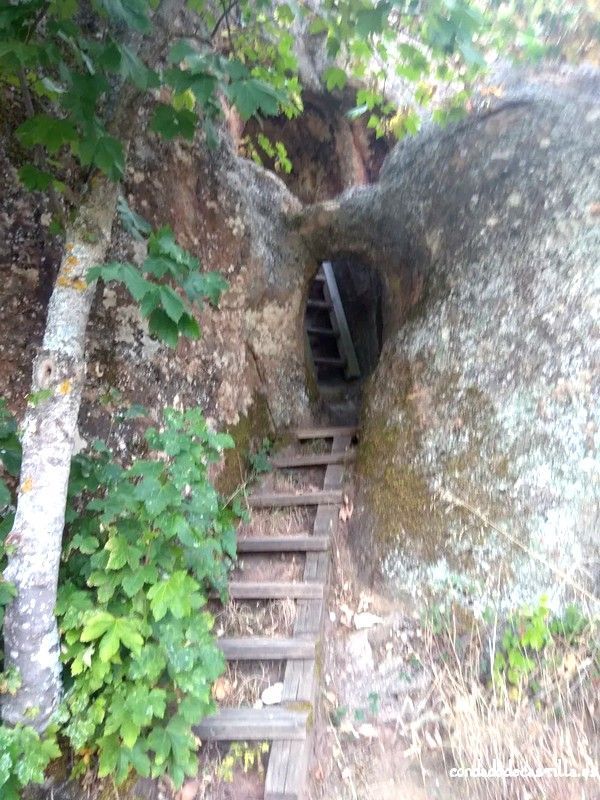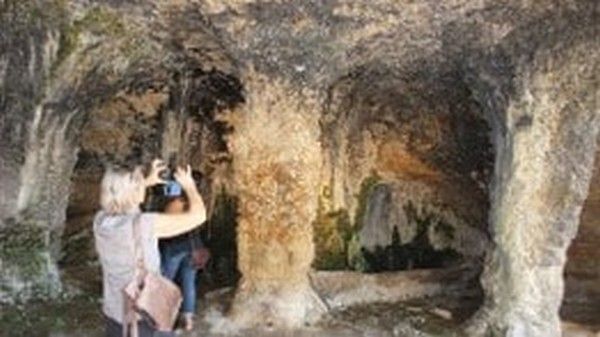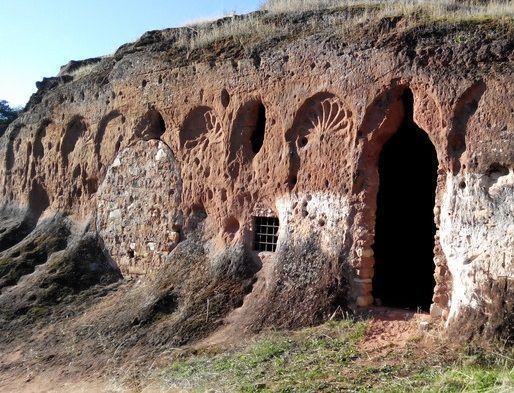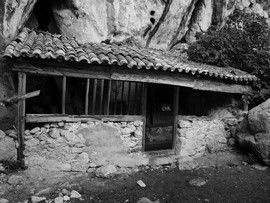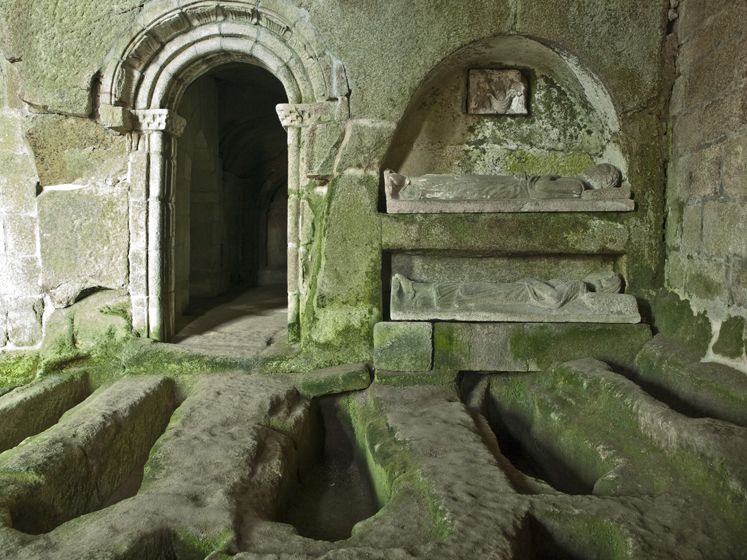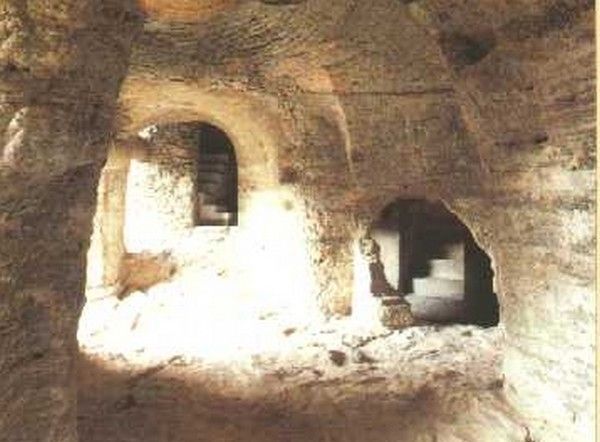Index of files of monuments
CASTILLEJOS DE QUINTANA
Hermitages - 9th Century - Málaga
Occupying a craggy hill at the northernmost end of the Sierra de Gibralmora (Pizarra), a kind of “small Bobastro” in which you can see a layout of the structures that make it up and a topography very similar to the Mesas de Villaverde . It is quite possible that the settlement was continuously occupied from the 7th to the 9th century, during the revolt of ʻUmar ibn Ḥafṣūn. The name given to this enclave, the true door of Bobastro, was that of Santa María.
CONJUNTO EREMÍTICO DE PEÑA ROTA (R)
Hermitages - 9th Century - Burgos
Located very close to Salas de los Infantes, it was partially dynamited at the beginning of the 20th century for the construction of a road. It is a hermit complex from the 8th and 9th centuries, which currently consists of 13 caves excavated in a large block of sandstone, of which several were only accessible by wooden stairs or stairs as the one existing in the only visitable. The rooms consisted of a wooden door, with a corridor leading to the cell, although there are two consisting of several cells with a single access corridor. There must also have been a cave temple that disappeared today.
CUEVA DE LA VIRGEN DE MONTESCLAROS
Hermitages - 10th Century - Cantabria
On a height between the beak Solaloma and the river Ebro, there raises Montesclaros’s Royal Sanctuary, place of secular Marian reference of the municipalities of Campoo’s Cantabrian region – The Valleys. Immediately after the excavations realized in the subsoil of the Sanctuary, in 1966, a pre-romanesque crypt was discovered on the cave. Of rectangular plant – of 3,5 meters of width for 3 of length – with an altar of stone adorned with a height of roped of white of egg Asturian influence (period ramirense) and in whose front is figured by symbols of Celtic tradition.
Cueva de San Martín
Hermitages - 9th Century - Zamora
The “Cave of St. Martín”is a small cave church with access through an arch created in the walled in part of the access to the cave and consists of a rectangular nave of 3.30 m by 3.60 m covered with a sort of basket-handle arch, that lets access to the apse through a horseshoe arch of 2.60 m diameter, covered with a dome. It is known it was utilized in the 9th and 10th centuries, but it is possible that it already existed from the 4th century.
CUEVA DE SIETE ALTARES (R)
Hermitages - 7th Century - Segovia
In the sickles of the river Duratón, near Sepúlveda one finds this eremitorio created in the 7th century by San Frutos and his brothers, missing person during the Arabic invasion. It was consisting of a public exterior, semiexcavated chapel, with an altar in the shape of horse-shoe. Entering a great arch, nowadays in very poor condition, another zone exists, with three excavated altars, also in the shape of horse-shoe, for use of the monks and more to the bottom the cells of the monks.
CUEVA SANTA DE LIEBANA
Hermitages - 9th Century - Cantabria
CUEVAS DE LOS PORTUGUESES DE ARROYO DE LAS TORCAS
Hermitages - 7th Century - Burgos
The isolated cave complex of Creek of the Torcas (La Horadada), in the Merindades (Burgos), consists of 14 rooms excavated in a wall of sandstone, in a small covered gorge of an exuberant grove, where a mighty creek flows shaping a curious secret habitat from the exterior.
EREMITORIO RUPESTRE DE LA MEZQUITA DE BUSQUÍSTAR
Hermitages - 8th Century - Granada
In the area known as “La Mezquita”, in the municipality of Busquístar (Granada), an ancient rock settlement identified as Mozarabic is preserved, at least six partially excavated rock enclosures are identified, as well as a staircase, a bathtub-type children’s grave, a well, mechinales for supporting the beams of the upper floors, as well as different cavities excavated in the rock.
ERMITA DE ARROYUELOS
Hermitages - 8th Century - Cantabria
ERMITA DE SAN PANTALEÓN
Hermitages - 8th Century - Cantabria
Remains of an isolated set placed in the high part of a crag, formed by a hermitage with the part it goes down the walls excavated in the rock, which was consisting of a nartex covered with a few stairs of access carved in the stone, a rectangular ship and an apse, besides a necrólolis in the sides this and south of the hermitage, and some cubicles excavated in the rock, which they should have been hermits’ cells.
IGLESIA RUPESTRE DE CAMPO DE EBRO
Hermitages - 8th Century - Cantabria
Semi cave hermitage built in a cave partly blocked with ashlars on one of its sides. It has a single plan formed by a rectangular nave and a quadrangular apse, separated by a semicircular arch, the whole carved on the rock. There is no consistent approach on whether it was built during the first christianization of the area at the end of the 6th and beginnings of the 7th centuries, or at the beginnings of the resettlement around the 9th century.
IGLESIA RUPESTRE DE COÍN
Hermitages - 9th Century - Málaga
Cave complex is located in the southernmost sector of a farmhouse, converted into the Andalusian village of Ḏakwīn/Coín, at the confluence of two regional roads. It is located on a prominent height very close to the historic center of Coín, so it must have belonged to a monastery in which a small monastic community must have functioned.
MONASTERIO RUPESTRE DE LA OSCURIDAD
Hermitages - 10th Century - Málaga
Church, from the 9th or 10th centuries, which can be valued as a simple church with a single nave or as a basilica, due to the rocky pillars that give way to a tripartite apse that would remind us in a certain sense of those of Bobastro, although the separation in three ships. In any case, there seems to be no doubt about its status as a monastic church of a suburban nature, since it was located outside the Ronda wall.
ORATORIO DE VALDECANALES
Hermitages - 7th Century - Jaén
Visigothic monastery consisting of three constructions excavated on the rock. The main one is formed by three naves covered with barrel vaults separated by square pillars presenting a monumental facade with a series of twelve horseshoe arches and timpanii decorated with palmettes. The two other caves might have been used as residence for the monks that lived in the prayer room, and the third one as a baptistry.
SAN JUAN DE SOCUEVA
Hermitages - 8th Century - Cantabria
Semi rock cave built by means of blocking the opening of a cave. It has a rectangular nave divided in two horizontal stretches and an apse with semicircular plan, covered with a semidome vault and separated from the nave by a triumphal horseshoe arch. It was declared Heritage of Cultural Interest in 1985.
SAN MIGUEL DE PRESILLAS
Hermitages - 8th Century - Burgos
SAN PEDRO DE ARGÉS
Hermitages - 10th Century - Burgos
SAN PEDRO DE ROCAS
Hermitages - 9th Century, 6th Century - Orense
The foundation stone from the year 573 has appeared, so it must originally have been a Swabian Christian hermitage. At the end of the 9th century, the monastery was refounded, to which Alfonso III granted privileges. It consists of three chapels excavated in the rock, communicated with each other, with horseshoe arches on attached columns and capitals carved in the same rock; It preserves the primitive altars in the form of tables and also decorated with horseshoe arches.
SAN PEDRO DE TARTALÉS
Hermitages - 9th Century - Burgos
SANTA MARIA DE LA CABEZA
Hermitages - 9th Century - Málaga
Monastic ensemble excavated on the rock, formed by a church and a living area. The church has an irregular shape and a total surface of 272 square metres. It has a central nave with trapezoidal plan ending in a semicircular apse, a vestry and other two naves with altars and niches on the end walls, located on the sides of the central one in a radial position starting at the main entrance with a semicircular arch.




